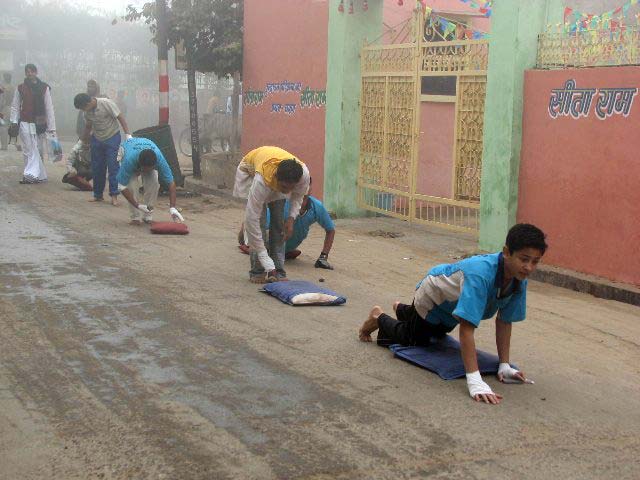Vrindavana Students Complete a ‘Dandavat Parikrama’
By Ananda Vrindavanesvari Dasi | Дек 15, 2007

Hundreds of devotees walk around Vrindavan every day on a special path called a parikrama marg. The walk itself is called parikrama, “sacred walk” or “sacred journey.” Circumambulating the town of Vrindavan on this path is a way to respect and honor this holy place.
A dandavat parikrama is a particular way to perform this sacred walk. Rather than walking, one circumbulates Vrindavan by offering prostrations on the ground, falling like a stick (the meaning of dandavat) again and again, until the entire path has been traversed.
Last week thirteen students from Bhaktivedanta Gurukula and International High School completed a dandavat parikrama. As part of their final year of gurukula, Grade 8 students must complete this challenge along the 11 km path. This is not an easy task – physically, emotionally, or spiritually – but the school requires it because it both prepares the students for more responsibility as they enter high school, and allows them to prove to themselves (and others) that they are ready for the independence, challenges, and new choices they will have to face as they enter young adulthood.
On a deeper level – one that is not easily assessed or judged – the dandavat parikrama is meant to allow students time with themselves and with Krishna, an internal exchange brought about by the difficulty of the parikrama. Here these young men face their own weakness, vunerability, and tininess, and thus an opportunity to be driven to experience shelter and strength from something (their resolve and mental control) and someone (the Lord) greater than themselves. They live on the edge, away from their usual daily activities, and change from young boys into young men.
The students spent five days on the path, staying in different ashrams each night. We asked them to keep a journal of their thoughts and in the evenings, around a campfire, they exchanged realisations with their friends and teachers.
Abhay from Switzerland writes, “I didn’t think I could do it. Every night I was exhausted, but the next day, once I started, my energy would come back. I was so happy when I was out there.”
Pravesh from Nepal wrote, “It was so difficult. There was dust everywhere, but I just kept chanting and pushing on. I would tell myself, ‘Just get to the next rest area.’”
“I was excited to do it but found it harder than I thought. I learned humility here, down on the ground, close to the earth and the small insects. I felt myself closer to Krishna,” commented Archit from New Delhi.
When the boys returned, bright-faced and energetic, I could see the power of the process. Austerities – performing difficult acts to bring about spiritual awakening – bring results. I could see those results on the faces of these young men.
In a final ceremony, they addressed the primary school (Gurukula Grades 1–8) and shared their experiences. They were then presented with their own personal copy of the Бхагавад-гита as their guidebook to life, as well as a harinam chadar and a Nrsimha pavitra.















